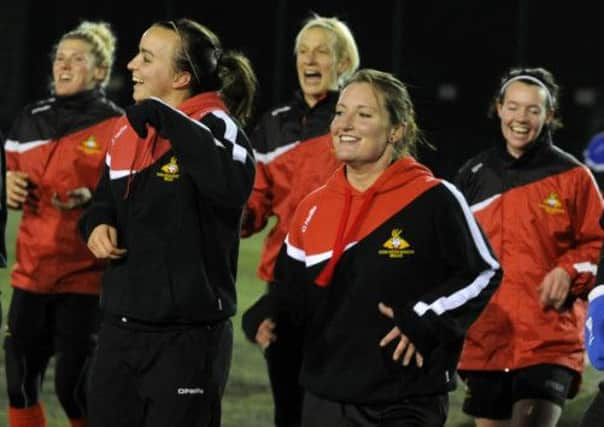Belles sounding out call for support as Olympics falters in delivering a legacy


Twenty-four thousand people watched Team GB defeat New Zealand 1-0 at Cardiff’s Millennium Stadium on July 25, an attendance that was just shy of the average gate of 25,422 for the 26 games.
The final at Wembley between the United States and Japan was watched by 80,203 people, while the lowest crowd was still in excess of 10,000 fans, for the USA’s quarter-final win over New Zealand.
Advertisement
Hide AdAdvertisement
Hide AdIn all, two-thirds of a million tickets were sold to watch women play football at London 2012, and yet every club in the English women’s Superleague would be well within their rights to ask where everyone has gone.
Doncaster Rovers Belles, Yorkshire’s representatives in the elite eight-team league of women’s semi-professional football, play their games in front of 300 people at the town’s Keepmoat Stadium.
In comparison to the vast numbers who watched women’s football at the Olympics, it almost comes under the category of one man and his dog.
The Belles are not alone. Arsenal, the champions and dominant force in women’s football, get under a thousand for all their games except Chelsea, when the London derby can attract 5,000. But other than an upsurge to 987 in their first game after the Olympics, the Gunners were soon back playing in front of fewer than 500.
Advertisement
Hide AdAdvertisement
Hide AdIt is a sorry statistic and an indictment of the promise of the Olympic organisers that there would be a legacy for all sports after the Games.
For Belles manager John Buckley, whose players returned to training last week ahead of the Superleague season kick-off in March, the lack of backsides on seats is a constant source of irritation.
“Most clubs feel that after the kick from the Olympics there would have been a big upturn in interest,” says Buckley, the former Rovers, Leeds and Rotherham player. “But if you look at the majority of sports, a number of them have seen attendances drop to what they were before the Games.
“And in women’s football, it’s not just us. We went to Everton and to Arsenal and the problem was the same there. There were 120 people at Everton.”
Advertisement
Hide AdAdvertisement
Hide AdWhat frustrates Buckley most is that standards in women’s football are on the rise, and that the women who play at club and international level deserve to be watched by more people.
“I went to the Canada versus United States women’s match at Old Trafford during the Olympics and it was one of the best games I’ve ever seen, for drama and for the skill on show,” says Buckley.
“I’ve seen every home game at Doncaster Rovers this season and there’s nothing to compare. Their recent performance in the win over Leyton Orient was probably the best it’s been, whereas we are battling to get people to come out and watch us.”
The cost of watching women’s football cannot be a contributing factor. Where a ticket to see the high-profile men’s game, even in the third tier, is more than £20, it costs less than a fiver to watch the Belles.
Advertisement
Hide AdAdvertisement
Hide AdAdults can watch games for £4, with concessions getting in for £2, money that Buckley rightly points out will not even get you parked for a Rovers game at the Keepmoat.
“Our attendances have gone up, but it is a slow process. For us to get 40 or 50 more people watching games would, to some, sound like hardly anything at all, but when you’re only getting 300 in the first place, that’s a 20 per cent increase.
“One problem for us could be our stadium; it’s so vast and almost empty when we’re playing. But do you then go to the expense of playing on a distinctly average pitch?”
Clubs are putting initiatives in place to attract new fans, even if it is just a fraction of those that headed to the Ricoh Arena in Coventry to watch Sweden and South Africa last summer.
Advertisement
Hide AdAdvertisement
Hide AdBuckley explains: “We’ve had this new initiative with player development which has seen 50 or 60 kids come down and take part. Off the back of that, we hope to get them involved in games at half-time, so then their families come down to watch that.
“We’ve also invited schools to come down and walk the teams out of the dressing room and onto the pitch before a game.
“It’s about connecting with the kids and it only needs a couple of really good games to set a word of mouth in motion.
“People in the game have to be genuinely serious about increasing attendances, not just saying they want to double gates when that’s unrealistic.
Advertisement
Hide AdAdvertisement
Hide Ad“There’s no point saying we want to be as big as the men’s game, that’s never going to happen, but, as a sport on its own, we can potentially do well for ourselves. It’s about finding the right initiative that gets people through the turnstiles.”
As well as broadening horizons, Buckley is also trying to make the Belles more competitive. They finished second bottom of the Superleague last season, suffering like clubs do in the men’s game from a disparity in finances.
Yet they remain one of the great names of women’s football and a big draw for girls of all ages in and around Yorkshire.
“We don’t have any financial backing from the men’s club, whereas others do,” says Buckley.
“It’s a hard task, but an enjoyable challenge.”